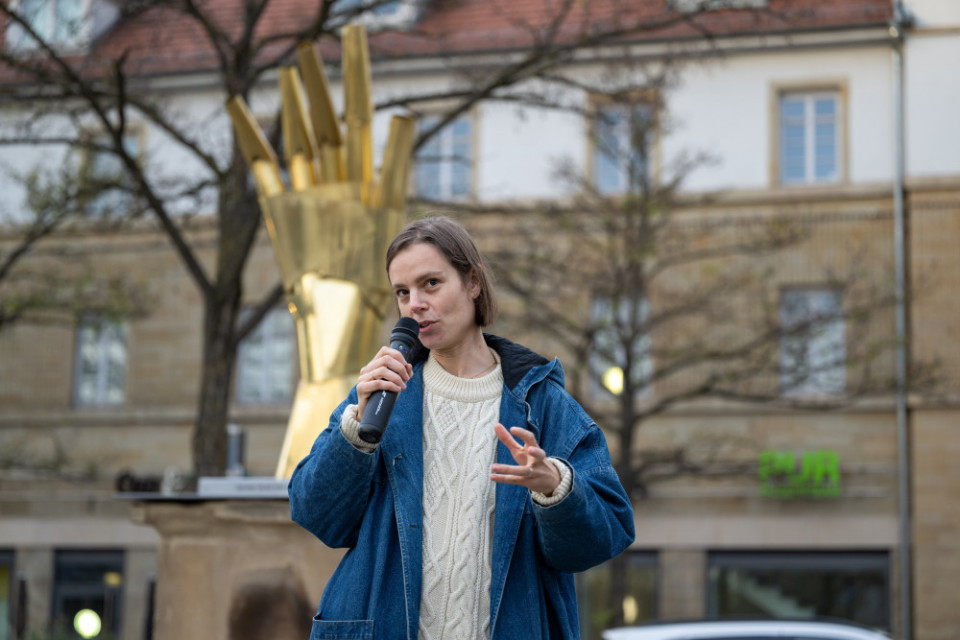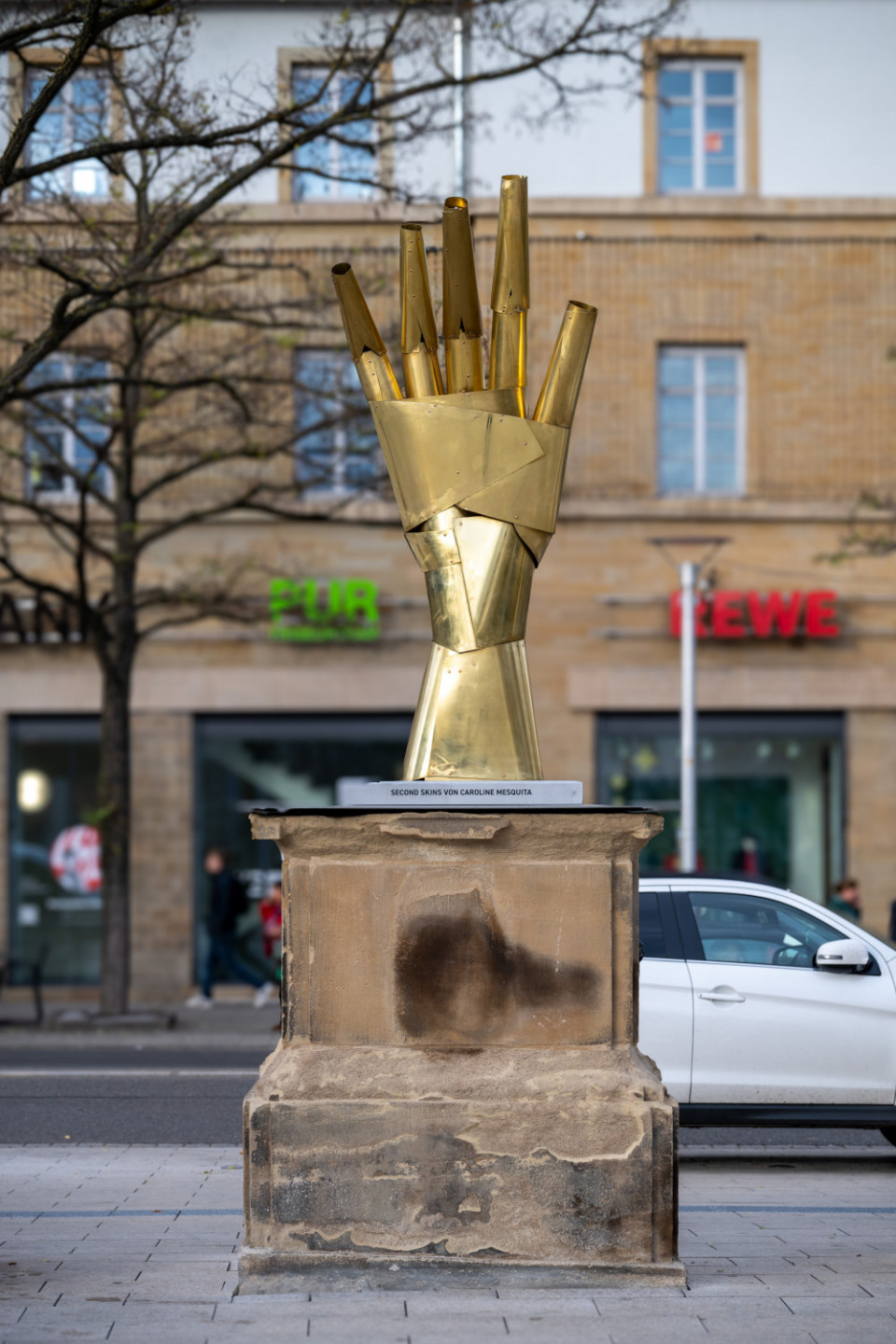Caroline Mesquita
Second Skins 75 years partnership between Ludwigsburg and Montbéliard
Outside {L’Arsenalplatz, Ludwigsburg}
In 2025, the city of Ludwigsburg celebrates the 75th anniversary of its partnership with Montbéliard — the very first French-German town twinning.
This partnership embodies friendship, exchange, and the will to build new bridges after the war.
Arsenalplatz is a particularly symbolic place for this anniversary: once a parade ground and military square of the Duchy of Württemberg, it was adorned with military trophies, symbols of power and victory. Today, only the historic plinths bear witness to this past. With the Second Skins project, this place is reinterpreted. Conceived in collaboration with the French art institution Le 19, Centre régional d’art contemporain, and the city of Montbéliard, the project proposes that a contemporary artwork enter into dialogue with the site’s history, transforming it in order to reveal other potentials and to spark new conversations and encounters.
Second Skins is an installation by French artist Caroline Mesquita. Invited to take over the plinths of Arsenalplatz, she unveils three brass sculptures representing hands.
These maintain an ambiguous relationship with the pedestals: while one hand sits proudly atop a plinth like a historical trophy, the other two approach with curiosity.
One appears to climb cautiously onto a plinth; the other descends from one with elegance. These hands seem to sense an absent presence, as if they were holding, in their hollow, the original sculptures they approach and discover. This absence evokes the transformation of public space in our societies. Whereas squares were once dedicated to the affirmation and display of power, they now function more as agoras.
What relevance, then, should we grant monuments of the past? And what new life could we imagine for them?
The installation will remain visible for one year. At the same time, the city is exploring how the historical trophies, currently kept at Ludwigsburg Palace, might in the future enter into dialogue with contemporary art. The official inauguration will take place on 15 November 2025, in the presence of guests from Montbéliard, representatives of both cities, and the inhabitants of Ludwigsburg. The project is intended as a pilot: in the long term, the city of Ludwigsburg aims to regularly reactivate the historical plinths of Arsenalplatz with temporary art installations created in cooperation with its partner cities — making this space a living place dedicated to art, memory, and international dialogue.
✱ The artwork – Second Skins
On Arsenalplatz, three brass hands enter into dialogue with the historic plinths — the last witnesses of a time when military trophies asserted power and victory. The title Second Skins evokes a protective second skin, close to armour, yet also capable of healing, regenerating, and reinventing itself. It becomes both a surface of memory and a site of contact, a space of relation to others.
The artist questions the new life of these public sculptures: that of the trophies, whose forms and details time has eroded, but also that of the hands, which arrived in Ludwigsburg after a different existence. This encounter invites us to observe their materiality: the stone of the ancient sculptures, once carved and combined with elements of armour, and the brass of the hands, which offers a contemporary reinterpretation wavering between the evocation of armour and that of jewellery. A parallel emerges between the metallic aspect of the former trophies and the rolled brass of the new forms, as if these materials were responding to one another across the ages.
In an almost sensual relationship, these seemingly animated hands — virtually, thanks to the appearance of the former sculptures in image form — reveal and touch these objects, weaving an eternal bond with them and offering them a second life. Hands and body fragments seem to complete each other.
✱ The artist – Caroline Mesquita
Caroline Mesquita, born in 1989 in Brest, lives and works in Marseille. Her sculptures, often made of metal — especially brass — combine technical mastery with an almost theatrical sensuality. She explores relationships between humans and objects, between movement and stillness. In her works, figures, machines, or body fragments appear engaged in a frozen dialogue, at once familiar and strangely distant. The metal she shapes is never inert: it oxidizes, transforms, and reacts to its environment.
✱ Arsenalplatz and the trophies
One of Ludwigsburg’s most historically charged places.
In the mid-18th century, it was designed on the orders of Duke Charles Eugene of Württemberg as part of the ducal military facilities — a space meant to manifest power, discipline, and order. In 1761, the first stone was laid for the Arsenal barracks, which served as the “main warehouse of the ducal military administration.” The square itself became the stage for parades, processions, and displays of military power.
It was adorned with six monumental stone trophies symbolizing victory over imaginary enemies. Composed of breastplates, helmets, shields, standards, swords, lances, and arrows, these sculpted ensembles expressed warlike superiority and defensive strength. Above the south wing of the building appeared the Latin inscription: Pacem arma firmant — “Weapons secure peace.” After the Second World War, Arsenalplatz lost its military function. Of the original sculptures, only the empty plinths remain — silent witnesses of a time when victory and violence were publicly celebrated.
✱ Perspectives – Art in public space and town twinning
The Trophies of Friendship aims to be the starting point for a long-term idea: Arsenalplatz is to be regularly reactivated, in cooperation with Ludwigsburg’s partner cities, through temporary artworks. Each project may question the square from a different perspective — its history, its emptiness, its meaning in today’s Europe. Thus a continuous dialogue emerges between past and present, between artistic research and international exchange. The historic plinths become an open archive, which can be rewritten again and again: alternately a place of memory, a stage, or a space of resonance.
✱ Project partners
A joint project of the cities of Ludwigsburg and Montbéliard, carried out by the Department of Art and Culture as well as the Department of Urban Development, Climate, and International Relations. Supported by the Heer Foundation, in collaboration with Le 19 – Centre régional d’art contemporain. Special thanks to the State of Baden-Württemberg and Vermögen und Bau, the Municipal Archives of Ludwigsburg, and the metal workshop Batz & Moosmüller.
Infos utiles
Free access – on view until November 2026.
Curator: Adeline Lépine

